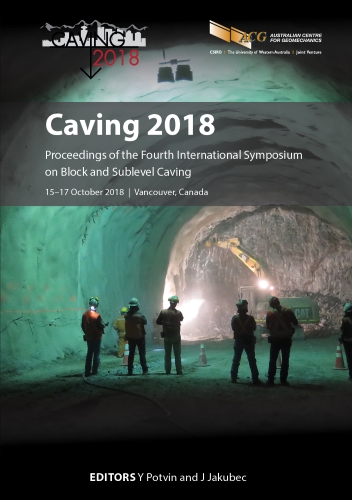Increasing productive capacity in block caving mines

|
Authors: Shelswell, KJ; Labrecque, PO; Morrison, DM |
DOI https://doi.org/10.36487/ACG_rep/1815_05_Morrison
Cite As:
Shelswell, KJ, Labrecque, PO & Morrison, DM 2018, 'Increasing productive capacity in block caving mines', in Y Potvin & J Jakubec (eds), Caving 2018: Proceedings of the Fourth International Symposium on Block and Sublevel Caving, Australian Centre for Geomechanics, Perth, pp. 107-118, https://doi.org/10.36487/ACG_rep/1815_05_Morrison
Abstract:
The block caving method requires the effective management of the induced stress conditions and the ore production system. We believe that the primary focus should be on the strategic design of the ore production system that will facilitate the management of the development activities involved in expanding the production footprint. A discrete event simulation was designed to quantify the impact of drawpoint loading methodologies on the productive capacity of block caving extraction footprints. The analysis of a conventional load–haul–dump (LHD) batch production process means it is very difficult for a 300 m wide footprint to reliably achieve a target of 100,000 tpd. It is always possible to increase the number of active extraction drives and the number of LHDs but this also increases the production cost and creates logistical problems. The analysis also shows that mine production rates much greater than 100,000 tpd can only be achieved by a continuous production system. This approach concentrates production within a smaller area with the potential for steeper caving angles. Higher production rates also shorten the life of drawpoints and reduce the risk of drawpoint failure. We believe the transition from a batch production system to a continuous production system will reduce the cost of production of current block caving operations and is essential if block caving operations are to reliably achieve production rates that are much higher than today.
Keywords: discrete event simulation, block caving productivity, continuous production system
References:
Atkinson, T 1992, ‘Selection and sizing of excavating equipment’, in HL Hartman (ed.), SME Mining Engineering Handbook, Volume 2, 2nd edn, Society for Mining, Metallurgy, and Exploration, Englewood, pp. 1311–1333.
Dirkx, R, Kazakidis, V & Dimitrakopoulos, R 2018, ‘Stochastic optimisation of long-term block cave scheduling with hang-up
Forbes, C, Evans, M, Hastings, N & Peacock, B 2011, Statistical Distributions, John Wiley & Sons, Hoboken.
Hamrin, H 1980, Guide to Underground Mining Methods and Applications, Atlas Copco, Stockholm.
Karnon, J, Stahl, J, Brennan, A, Caro, JJ, Mar, J & Möller, J 2012, ‘Modeling using discrete event simulation: a report of the ISPORSMDM Modeling Good Research Practices Task Force-4’ Value In Health, vol. 15, no. 6, pp. 821–827.
Kurniawan, C & Setyoko, TB 2008, ‘Impact of rock type variability on production rates and scheduling at the DOZ-ESZ block cave mine’, in H Schunnesson & E Nordlund (eds), Proceedings of MassMin 2008, Luleå, pp. 291–301.
Laubscher, DH 1994, ‘Cave mining – the state of the art’, Journal of the South African Institute of Mining and Metallurgy, vol. 94, no. 10, pp. 279–293.
Law, AM & Kelton, WD 1991, Simulation Modelling and Analysis, 2nd edn, McGraw-Hill Inc., New York.
Onyango, JP & Plews, AM 1987, A Textbook of Basic Statistics, East African Educational Publishers Ltd., Nairobi.
Rahal, D, Smith, M, van Hout, G & von Johannides, A 2003, ‘The use of mixed integer linear programming for long-term scheduling in block caving mines’, in FA Camisani-Calzolari (ed.), Proceedings of the 31st Symposium on Application of Computers and Operations Research in the Minerals Industries, South African Institute of Mining and Metallurgy, Johannesburg, pp. 123–132.
Rahal, D & Smith, M 2004, ‘A draw control system for scheduling production in block caving’, in A Karzulovic & MA Alfaro (eds), Proceedings of MassMin 2004, Instituto de Ingenieros de Chile, Santiago, pp. 479–485.
Rashidi-Nejad, F, Suorineni, FT & Asi, B 2014, ‘Open pit or block caving? A numerical ranking method for selection’, Proceedings of the 2014 Society of Mining Professors Annual Meeting, The Southern African Institute of Mining and Metallurgy, Johannesburg, pp. 183–199.
Robinson, S 2004, Simulation: The Practice of Model Development and Use, John Wiley & Sons, West Sussex.
Rockwell Automation 2014, Arena User’s Guide, Rockwell Software Inc., Milwaukee.
Shelswell, KJ & Labrecque, PO 2014, ‘Discrete simulations quantifying the effects of material handling conveyors in series or parallel oreflow streams’, Proceedings of the Society for Mining, Metallurgy & Exploration Annual Meeting, Society for Mining, Metallurgy & Exploration, Englewood.
Srikant, A 2006, ‘Fragment size estimation and measurement in the DOZ block cave’, Mining Engineering, vol. 58, no. 10, pp. 43–47.
© Copyright 2025, Australian Centre for Geomechanics (ACG), The University of Western Australia. All rights reserved.
View copyright/legal information
Please direct any queries or error reports to repository-acg@uwa.edu.au
View copyright/legal information
Please direct any queries or error reports to repository-acg@uwa.edu.au
